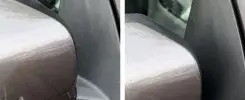Tar Removal: Defeating Sticky Situations
Greetings, we’re about to tackle a sticky situation literally. We’re diving into the world of tar removal, a vital tool in every car owner’s arsenal when it comes to maintaining the pristine condition of their beloved vehicles.
The Sticky Situation: Tar Deposits
As you drive down the open road, your car’s tyres come into contact with all sorts of surfaces, from freshly laid tarmac to old, weathered roads. Along the way, they often pick up a common nuisance tar deposits. These dark, sticky substances can stick to your vehicle’s exterior, marring its appearance and potentially causing damage if left untreated.
Why Tar Remover Matters
Before we delve into the specifics of tar removal, let’s explore why it’s crucial for car care:
1. Looks: Tar deposits can be unsightly, creating dark spots and streaks on your car’s finish. Tar remover helps restore your vehicle’s looks, making it look clean and well maintained.
2. Prevents Paint Damage: Over time, tar can harden and become more challenging to remove. If left untreated, it can potentially damage your car’s paint, leading to costly repairs.
3. Preserves Resale Value: Regularly removing tar deposits and keeping your car’s exterior in top condition can help maintain its resale value. A well kept vehicle is more attractive to potential buyers.
4. Safe for All Surfaces: Tar remover products are designed to be safe for various surfaces, including paint, chrome, glass, and plastic, ensuring you can tackle tar related issues without any problems.
The Tar Removal Process
Now, let’s shine some light on the step-by-step process of removing tar deposits from your vehicle:
1. Gather Your Supplies: You’ll need a quality tar remover product, clean microfiber towels, and gloves to protect your hands.
2. Choose a Shaded Area: Work in a shaded area to prevent the tar remover from evaporating quickly in direct sunlight.
3. Pre-Wash Your Vehicle: Start by washing your car thoroughly to remove loose dirt and contaminants. This ensures that the tar remover can focus on the sticky tar deposits.
4. Apply the Tar Remover: Follow the product instructions carefully. Typically, you’ll spray or apply the tar remover directly onto the affected areas. Allow it to dwell for a minute or two to soften the tar.
5. Gently Rub or Wipe: Using a clean microfiber towel, gently rub or wipe the affected area. Avoid using excessive pressure, as this could potentially damage your car’s finish.
6. Repeat as Needed: Depending on the severity of the tar deposits, you may need to repeat the process several times. Be patient and persistent to ensure thorough removal.
7. Rinse and Wash Again: After removing the tar, rinse the affected area with clean water and wash your car again to remove any residual tar remover and ensure a clean finish.
8. Wax or Seal: After tar removal, consider applying a layer of wax or sealant to protect the treated area and maintain your car’s appearance.
In Conclusion
Tar remover is your trusty companion when it comes to defeating sticky situations on your car’s exterior. By addressing tar deposits promptly, you not only preserve the looks and value of your vehicle but also ensure that it continues to turn heads wherever the road takes you. So, don’t let sticky situations stick around for too long equip yourself with tar remover and keep your car looking its best. Happy driving!



